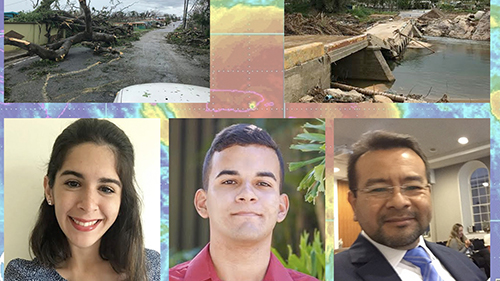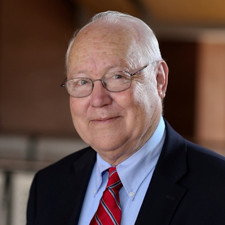
This past summer, Coastal Resilience Center researchers formed unique partnerships to investigate faster and more accurate ways to model hurricanes, as well as a tool to track the well-being of those experiencing those storms first-hand.
Through the Summer Research Team for Minority-Serving Institutions program, three teams – from University of Puerto Rico-Mayagüez (UPRM), North Carolina A&T University (NCA&T) and Fayetteville State University (FSU) – worked with Coastal Resilience Center researchers from June to August on short-term research projects, and recently completed final reports on that work.
Wellness app for severe weather victims

Dr. Mauricio Cabrera-Ríos of URPM worked with CRC Executive Director Tom Richardson and Education & Workforce Development Director Dr. Robert Whalin of Jackson State University on a project called “Individual Emergency Response and Recovery: A learning experience from Puerto Rico’s encounter with Hurricane María.” Along with UPRM graduate student Véronica Diaz-Pacheco and undergraduate Frederick Gonzalez-Roman, they developed an operations research model to assess the compound wellness level of individuals who experience hazards such as hurricanes.
The research team aimed to determine the series of individual decisions necessary to maximize the chance of surviving a hurricane like 2017’s María, during and after the event. The project involved three stages: Survey and statistical analysis, developing a statistical model and coding a prototype. According to their final report, the team created an app, iWILL (Individual Wellness Inventory Level Log), that queries users every two hours during disaster events. The app would register detrimental events, reflect the decrease in the person’s wellness and propose up to three restorative measures from which the user can choose.

“The app reflects the restorative effects in time, allowing the user to monitor wellness as a result of personal decision-making as well as review his/her response in perspective,” Dr. Cabrera-Ríos wrote in the report.

In the future, it is expected that a more formal version of the app be made available to the public in hurricane-prone areas and a scaled-up version of the system be developed to aid emergency-management agencies. Diaz-Pacheco plans to use this research program as the basis for her graduate research, and Dr. Cabrera-Ríos plans to use the case study and ideas from the summer as part of hands-on projects for his students in his Artificial Intelligence courses.
“Having experienced Hurricane María first-hand ourselves, we knew that until support can reach you, it is individuals holding the reins of their response and recovery,” Díaz Pacheco wrote in a blog post for CRC. “For this reason, our specific goal with the project was to develop a decision support tool that could help individuals during hurricanes.”
Improving weather research and forecasting education

Dr. Liping Liu of NCA&T worked with CRC Lead Principal Investigator Dr. Rick Luettich of the University of North Carolina-Chapel Hill on a project called “Combined Atmospheric-Storm Surge Modeling of Hurricane Florence (2018).” Along with NCA&T graduate student Tiana Johnson and undergraduate student Jackson Wiles, the team studied the Weather Research and Forecasting (WRF) atmospheric model to improve weather research and forecasting research capacity at NCA&T. Dr. Liu plans to develop classroom plans integrating severe weather and numerical prediction of those events into courses.

During the summer, the team worked with data on 2018’s Hurricane Florence, which combined rainfall totals of 25-30 inches over eastern North Carolina with maximum storm surge of 8-11 feet. The team worked on atmospheric modeling for a good hindcast of the storm, with special attention paid to variables such as wind, pressure and precipitation, to be imported into the ADCIRC model to predict time, location and intensity of flooding from both rainfall and surge. They ran more than 60 simulations with adjustments to various simulation settings, then compared their model results with official observation data from Hurricane Florence.

In their final report, the team found that overall, the WRF results matched reasonably well with the observation data after two-day simulations, though the storm track accuracy is sensitive to the region being simulated and other parameters.

“Findings of the project will improve the representations or parameterizations of the atmospheric environmental conditions,” Dr. Liu wrote in the report. “[This] will improve storm weather prediction and lead to increased public safety, reduced loss of property and life, especially for people along the East Coast.”
Johnson and Wiles wrote about their experience in a CRC blog post.
Teaching AI about storm surge

Dr. Sambit Bhattacharya of FSU worked with CRC researcher Dr. Brian Blanton of the Renaissance Computing Institute at UNC on a project called “Storm Surge Prediction with Integration of Physical Knowledge in Machine Learning Models.” They and students Raymond Kimble and Grace Vincent used artificial intelligence and machine learning to create an advanced hybrid model trained with experimental and simulated data to predict storm surge.

In the team’s final report, they report that their aim was to integrate an artificial neural network with the physical modeling of ADCIRC for making storm surge prediction, reducing computing resources used while maintaining accurate predictions. The team reported that the artificial neural network performed well with a basic water level time series – in which water level rise was consistent – but faced challenges with variables such as a shift in wind direction.

“The SRT experience was enriching because it introduced [me] to a scientific domain which has challenging problems and is of great benefit to society,” Dr. Bhattacharya wrote in the report. “[I] will use ideas and use-cases inspired by the SRT experience to create hands-on project-based learning modules for the Artificial Intelligence courses.”

The Summer Research Team for Minority-Serving Institutions program, administered by the Department of Homeland Security’s Science & Technology Directorate’s Office of University Programs and Oak Ridge Associated Universities, engages early career faculty, undergraduate and graduate students in research at the COEs, providing opportunities to better understand DHS mission and research needs and make advances in DHS research areas. Research typically takes place between May and August.
